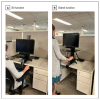Sit-Stand Desks and Physical Self-care Behaviors in a Family Medicine Residency
- PMID: 36119904
- PMCID: PMC9477717
- DOI: 10.22454/PRiMER.2022.938058
Sit-Stand Desks and Physical Self-care Behaviors in a Family Medicine Residency
Abstract
Introduction: More than 50% of primary care physicians' practice involves sedentary desk work. Growing evidence suggests a link between sedentary workplace behaviors and increased morbidity and mortality. Research on the effects of sit-stand desks in the workplace suggests that sit-stand desks reduce sedentary behaviors. This study examined the use and satisfaction of adjustable desks with a height of sit-stand and their association with physical self-care behaviors among family medicine residents.
Methods: We conducted a longitudinal cohort survey study at a 9-9-9 family medicine residency after the clinic installed height-adjustable sit-stand desks in January 2020. Standardized questions about the use and satisfaction of adjustable sit-stand desks and physical self-care behaviors were administered in June 2020, December 2020, and December 2021. The survey also included an open text box for feedback.
Results: Median time spent standing at the sit-stand desks was 55.0%. The percentage of time standing was similar across June 2020, December 2020, and December 2021. The average satisfaction rate with the desks across all time points was 71.4%. We did not observe significant differences in the proportion of residents' satisfaction with the adjustable desks over time. Residents who reported standing at the adjustable desk reported increased satisfaction with the desks (Kendall's τ=.38, P<.001) and with physical self-care behaviors (Kendall's τ=.25, P<.05). Themes associated with desk dissatisfaction revolved around limited desktop space.
Conclusion: Over a nearly 1.5-year period, more than half of family medicine residents reported standing at their adjustable desks and being satisfied with them. Residents who reported standing at adjustable desks also reported increased physical self-care behaviors. Residency programs investing in sit-stand desks may consider options that allow for increased desktop surface space.
© 2022 by the Society of Teachers of Family Medicine.
Similar articles
-
Impact of Sit-to-Stand and Treadmill Desks on Patterns of Daily Waking Physical Behaviors Among Overweight and Obese Seated Office Workers: Cluster Randomized Controlled Trial.J Med Internet Res. 2023 May 16;25:e43018. doi: 10.2196/43018. J Med Internet Res. 2023. PMID: 37191995 Free PMC article. Clinical Trial.
-
"If money was no object": A qualitative study of South African university office workers' perceptions of using height-adjustable sit-stand desks.S Afr J Sports Med. 2022 Jan 1;34(1):v34i1a13881. doi: 10.17159/2078-516X/2022/v34i1a13881. eCollection 2022. S Afr J Sports Med. 2022. PMID: 36815905 Free PMC article.
-
Introducing sit-stand desks increases classroom standing time among university students.Prev Med Rep. 2017 Nov 9;8:232-237. doi: 10.1016/j.pmedr.2017.10.019. eCollection 2017 Dec. Prev Med Rep. 2017. PMID: 29159019 Free PMC article.
-
Workplace interventions for reducing sitting at work.Cochrane Database Syst Rev. 2018 Dec 17;12(12):CD010912. doi: 10.1002/14651858.CD010912.pub5. Cochrane Database Syst Rev. 2018. PMID: 30556590 Free PMC article.
-
Implications of sit-stand and active workstations to counteract the adverse effects of sedentary work: A comprehensive review.Work. 2015;52(2):255-67. doi: 10.3233/WOR-152168. Work. 2015. PMID: 26444941 Review.
References
-
- Katzmarzyk PT, Powell KE, Jakicic JM, Troiano RP, Piercy K, Tennant B. 2018 Physical Activity Guidelines Advisory Committee. Sedentary Behavior and Health: Update from the 2018 Physical Activity Guidelines Advisory Committee. Med Sci Sports Exerc. 2019;51(6):1227–1241. doi: 10.1249/MSS.0000000000001935. - DOI - PMC - PubMed
LinkOut - more resources
Full Text Sources

